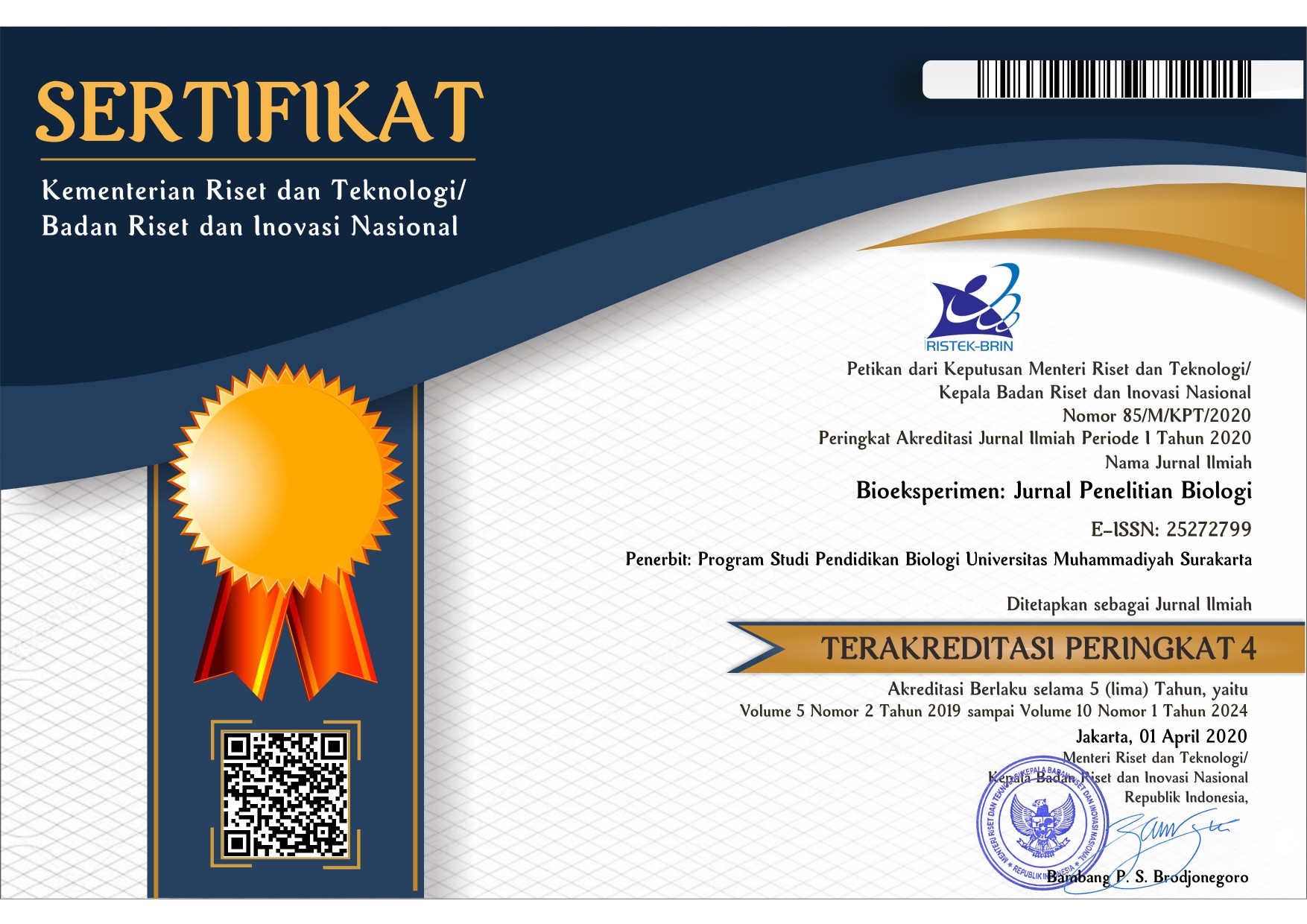A Diversity of Copepods in Gajah Mungkur in Wonogiri Regency, Central Java, Indonesia
Efri Roziaty(1*), Afrika Arianto(2), Vina Listiawati(3)(1) Biology Education, Faculty of Teacher Training and Education, Universitas Muhammadiyah Surakarta, Indonesia. Center for Environmental Studies, Universitas Muhammadiyah Surakarta
(2) Biology Education, Faculty of Teacher Training and Education, Universitas Muhammadiyah Surakarta
(3) Graduate School of Engineering and Science, University of the Ryukyus
(*) Corresponding Author
Abstract
GajahMungkur Reservoir is a freshwater ecosystem thatis located6kmsouthofWonogiri Regency,CentralJavaProvince. Zooplankton is the primary consumer in the food chain of aquatic ecosystems. One of the common zooplankton found in freshwater ecosystem is copepod. Copepod is sensitive organism and play an important role as bioindicatator of water quality. The aimed of this study was to investigate the copepods diversity in Gajah Mungkur Reservoir. The method applied to this study is exploration and application of purposive sampling techniques in sampling. Copepods were collected from three different station, namely Station 1 (fishing area), Station 2 (tourism area), and Station 3 (fish cage area or keramba). The abiotic parameters were found to be varied on each station. Results showed that Gajah Mungkur Reservoir has moderately diverse copepods species with the average of diversity index 1.21. There were 7 species of copepods found in Gajah Mungkur Reservoir which mostly dominated by Mesocyclops sp., especially in Station 1 (fishing area). Meanwhile Microcyclops sp. was only found in Station 3 (fish cage area or keramba), suggesting that this species has a potential as bioindicator in Gajah Mungkur Reservoir. This study suggest that changes in physicochemical parameters might influence the diversity and abundance of copepod in Gajah Mungkur Reservoir.
Keywords
Full Text:
PDFReferences
Drira, Z., Kmiha-Megdiche, S., Sahnoun, H., Pagano, M., Tedetti, & Ayadi, H. (2018). Water Quality Affects the Structure of Copepod Assemblages along the Sfax Southern Coast (Tunisia, Southern Mediterranean Sea). Marine and Freshwater Research, 69(2), 220–231. https://doi.org/10.1071/MF17133ï
Mulyadi, & Murniati, D. (2017). Diversity, Abundance, and Distribution of Copepods (Crustacea) in the Mangrove Area of Segara Anakan, Cilacap. Oseanologi Dan Limnologi Di Indonesia , 2(2), 21–31.
Perbiche-Neves, G., & Nogueira, M. G. (2013). Reservoir design and operation: Effects on aquatic biota-a case study of planktonic copepods. Hydrobiologia, 707(1), 187–198. https://doi.org/10.1007/s10750-012-1425-1.
Rayshita, L. (2021). Distribusi Spasial Kelimpahan Subclassis Copepoda di Perairan Muara Sungai Musi Sumatera Selatan.
Santhosh, E. B., K, A. M., Anzeer, M. F., S, A. K., Abraham, M. V, & Mary George, R. (2018). Culture Techniques of Marine Copepods. www.cmfri.org.in.
Setiawan, H., Idiawati, N., & Helena, S. (2022). Komposisi dan Struktur Komunitas Copepoda di Estuari Desa Mendalok Kabupaten Mempawah Kalimantan Barat Composition and Structure of the Copepoda Community in the Estuary of Mendalok Village, Mempawah Regency, West Kalimantan. In Jurnal Laut Khatulistiwa (Vol. 5, Issue 2). Online. http://jurnal.untan.ac.id/index.php/lk.
Sitharam, T. G. (2017). Efficacy of coastal reservoirs to address India’s water shortage by impounding excess river flood waters near the coast. Journal of Sustainable Urbanization, Planning and Progress, 2(2), 49–54. https://doi.org/10.26789/jsupp.2017.02.008
Wisnu, I., Muryani C., & Ahmad. (2019). Spatial analysis of coliform bacteria contained in phreatic water in colomadu sub-district karanganyar. In 12 (Ed.), IOP Conference Series: Earth and Environmental Science (Vol. 683, Issue 1, pp. 1–10). IOP Publishing Ltd. https://doi.org/10.1088/1755-1315/683/1/012001
Article Metrics
Abstract view(s): 406 time(s)PDF: 283 time(s)
Refbacks
- There are currently no refbacks.








